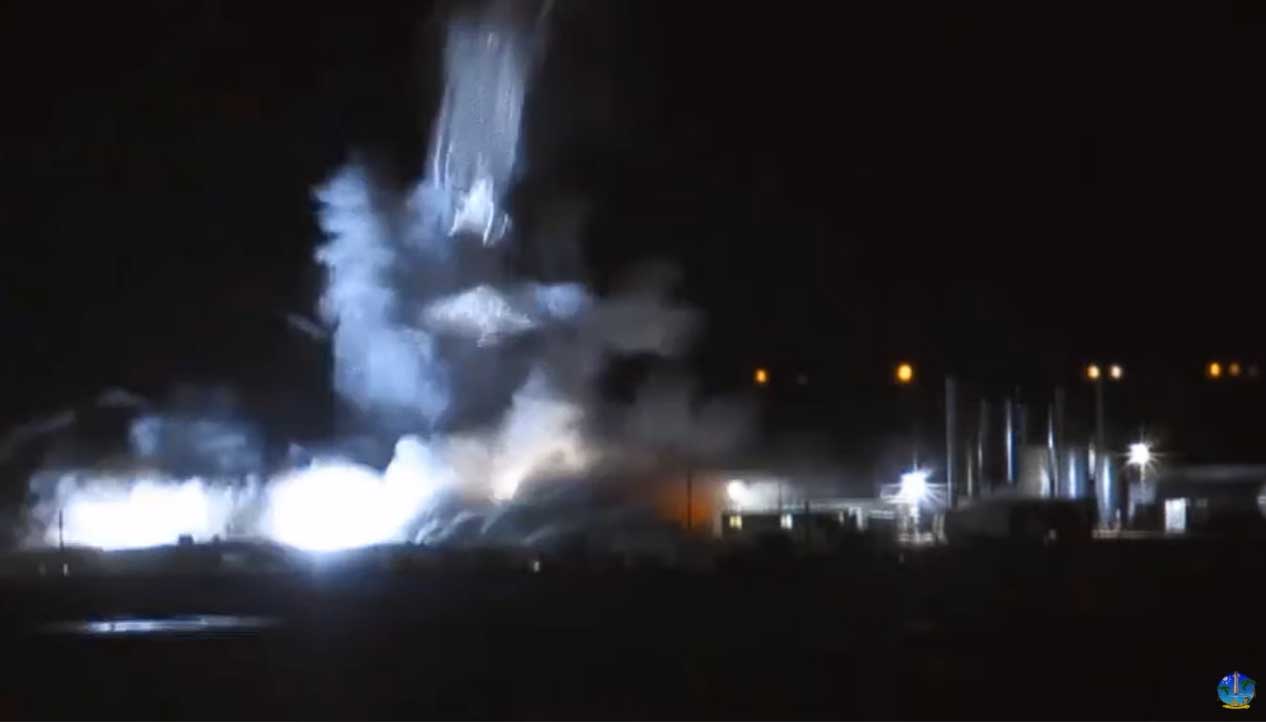
Elon Musk seems to be taking SpaceX's recent Starship setback in stride.
On Friday night (Feb. 28), the second full-size prototype of SpaceX's Mars-colonizing Starship vehicle, a variant known as the SN1, was destroyed during a pressurization test.
SpaceX had been aiming to launch the SN1 on a test mission relatively soon. In late December 2019, Musk said via Twitter that the prototype's first flight, which would stay firmly within Earth's atmosphere, was "hopefully 2 to 3 months away."
Related: SpaceX's Starship and Super Heavy rocket in pictures
Musk didn't immediately tweet about Friday night's incident. But the billionaire entrepreneur posted a few items early Monday morning (March 2) that suggest he's not dwelling on the SN1's demise.
"So … how was your night?" read one tweet, which accompanied a video of the prototype's death. This was followed by "It's fine, we’ll just buff it out," and then another tweet that said, "Where’s Flextape when you need it!?"
And in yet another Monday-morning tweet, Musk said that SpaceX has shifted its focus to the next prototype iteration, the SN2, which is already under construction.
Get the Space.com Newsletter
Breaking space news, the latest updates on rocket launches, skywatching events and more!
"We're stripping SN2 to bare minimum to test the thrust puck to dome weld under pressure, first with water, then at cryo. Hopefully ready to test in a few days," Musk wrote.
We’re stripping SN2 to bare minimum to test the thrust puck to dome weld under pressure, first with water, then at cryo. Hopefully, ready to test in a few days.March 2, 2020
It shouldn't be surprising that Musk isn't more broken up about the SN1; he has stressed, after all, that SpaceX will go through many prototype iterations on its way to an operational Starship. In a tweet on Dec. 27, 2019, for example, Musk explained that "each SN will have at least minor improvements, at least through SN20 or so of Starship V1.0."
And the SN line itself represents a redesign spurred at least in part by a November 2019 pressure-test incident involving SpaceX's first full-size Starship prototype, the Mark 1.
The Starship spacecraft is half of SpaceX's planned Mars-colonizing transportation system, which also includes a huge rocket known as Super Heavy. Both vehicles are designed to be completely and rapidly reusable.
Super Heavy will launch the 100-passenger Starship to orbit, then come back down to Earth for a vertical landing. The 165-foot-tall (50 meters) Starship, meanwhile, will head from Earth orbit to the moon, Mars and other distant destinations. And the spaceship will return to Earth's neighborhood when its journeys afar are done; Starship is powerful enough to launch itself off the surface of the moon and Mars, both of whose gravitational pulls are much weaker than that of Earth, Musk has said.
Musk envisions a fleet of 1,000 Starships departing for Mars once every 26 months, when Earth and the Red Planet align favorably for interplanetary missions. Such flights will eventually help establish a million-person city on Mars, if all goes according to SpaceX's plan.
It's unclear when that ambitious goal may be achieved. But SpaceX plans to get Starship and Super Heavy up and running soon. Company representatives have said that Starship could start launching communications satellites to Earth orbit by 2021.
And SpaceX has one crewed Starship mission on the docket already: Japanese billionaire Yusaku Maezawa booked the vehicle for an around-the-moon flight that's scheduled to launch in 2023.
- SpaceX's new Starship prototype could fly in just 3 months, Elon Musk says
- SpaceX: Facts about Elon Musk's private spaceflight company
- How living on Mars could challenge colonists (infographic)
Mike Wall is the author of "Out There" (Grand Central Publishing, 2018; illustrated by Karl Tate), a book about the search for alien life. Follow him on Twitter @michaeldwall. Follow us on Twitter @Spacedotcom or Facebook.
OFFER: Save at least 56% with our latest magazine deal!
All About Space magazine takes you on an awe-inspiring journey through our solar system and beyond, from the amazing technology and spacecraft that enables humanity to venture into orbit, to the complexities of space science.
Join our Space Forums to keep talking space on the latest missions, night sky and more! And if you have a news tip, correction or comment, let us know at: community@space.com.

Michael Wall is a Senior Space Writer with Space.com and joined the team in 2010. He primarily covers exoplanets, spaceflight and military space, but has been known to dabble in the space art beat. His book about the search for alien life, "Out There," was published on Nov. 13, 2018. Before becoming a science writer, Michael worked as a herpetologist and wildlife biologist. He has a Ph.D. in evolutionary biology from the University of Sydney, Australia, a bachelor's degree from the University of Arizona, and a graduate certificate in science writing from the University of California, Santa Cruz. To find out what his latest project is, you can follow Michael on Twitter.










